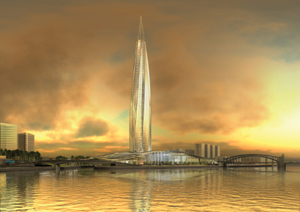Gazprom City, the planned 1,050-foot-tall headquarters in St. Petersburg for the energy giant Gazprom, has been rechristened the “Okhta Center,” which refers to the traditional name for the neighborhood where it could be built. The skyscraper’s name may have softened, but not its potentially harsh visual impact on the historical skyline.

UNESCO cautioned in August that if the tower, designed by Edinburgh-based RMJM, is built as planned, St. Petersburg risks losing “world heritage” status, which it has held since 1990 and confers a degree of cultural prestige and legitimacy. The warning came as the latest sign of international disapproval after the World Monuments Fund included the city’s skyline on its Watch List of the 100 Most Endangered Sites earlier this year. Both groups object to the tower’s height, which exceeds current limits. The United Nations Educational Scientific and Cultural Organization claims that it registered concern about the project with Russian authorities last year but failed to receive adequate responses to its request for more information.
St. Petersburg authorities have been given until February 1, 2008 to submit a report detailing the Okhta Center’s impact on the existing built environment. In the meantime, UNESCO officials are scheduled to meet in November with representatives of RMJM, which won an international competition to design the tower last year, to assess any adjustments that have been made. Although RMJM has declined to comment fully until after these talks, it released a statement by Tony Kettle, lead architect and managing director of RMJM’s U.K. division, saying that it is “continuing to consult with interested heritage groups, including UNESCO, over the coming weeks and will be providing them with full details of the design proposals.”
A subcontractor is due to be selected this week to carry out the site’s geological inspection, and demolition of industrial buildings that occupy the site is already underway. Gazprom has in recent months compromised on issues more substantial than the building’s name. It agreed to finance a larger share of the expenses, while allotting more space for public purposes. Gazprom will occupy just 16 percent of the complex, with an additional 49 percent designated for other office tenants and 35 percent set aside for social and cultural use. According to the revised agreement, the city will underwrite roughly $1.18 billion of the project’s cost, down from $2.4 billion in the original deal, for a 49 percent stake in the complex.
Russian officials have so far brushed aside UNESCO’s concerns because the final design scheme has yet to be presented and approved. But without a fixed timeline for when these internal deliberations will be concluded, there is no guarantee that UNESCO will receive a report by February.


